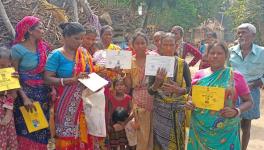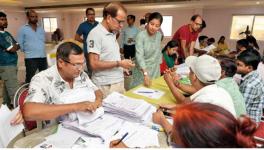Elections 2019: ‘Mother’ Ganga Awaits Her ‘Son’ Modi to Accomplish Task of Cleaning
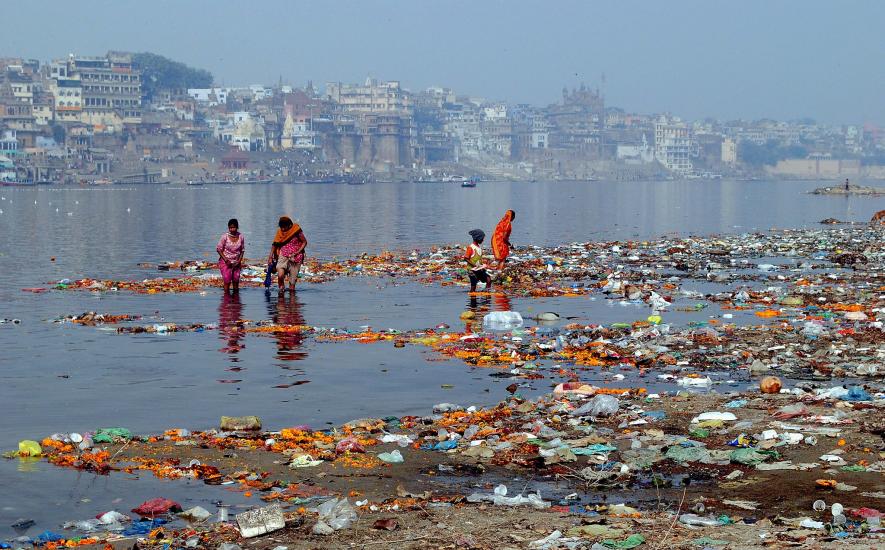
Varanasi (Uttar Pradesh): “Ganga does not flow here anymore,” yelled a visibly frustrated boatman in Varanasi who was struggling to row his boat, which had stopped moving forward. “Once a mighty river, which used to give a tough time to the boatmen rowing upstream, now seems like a slow moving pond with sludge and mounds of garbage,” he said.
Despite the Prime Minister Narendra Modi government’s tall claims to clean Ganga, the water in the holy river – as it flows through the ancient town, which is known for its ghats and temples – has high level of pollutants and untreated sewage.
The spiritual town from the Eastern region of Uttar Pradesh grabbed the national spotlight especially after it elected Modi to represent it in Parliament. Modi, during his first visit to his constituency as a PM, had promised to clean Ganga, calling the river his mother.
However, this promise is yet to be fulfilled even after he has completed a full term (five years) of his government. Despite the sanction of Rs 27.28 crore under the Namami Gange project to the ‘River Front Development’, the untreated sewage continues to flow into the river.
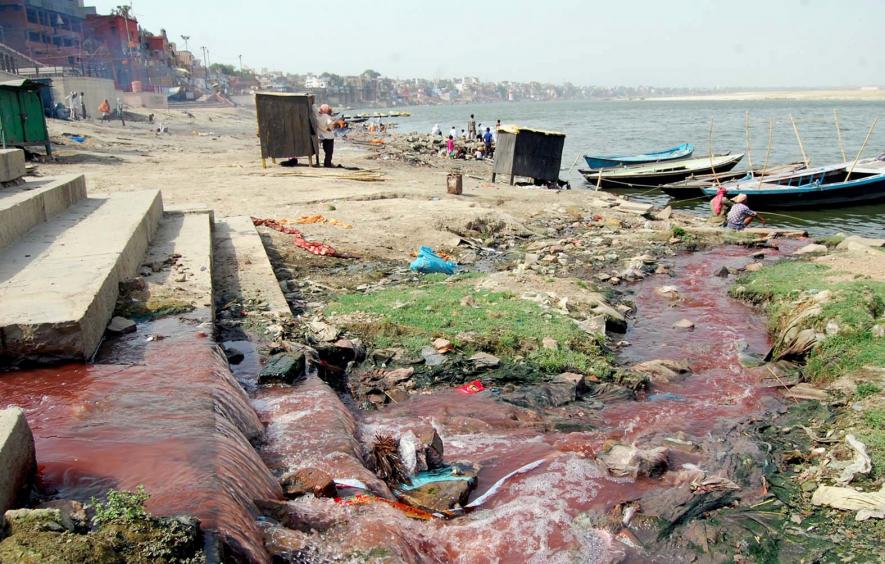
Initiatives to clean river Ganga began with the Ganga Action Plan I in 1986. Till 2014, over Rs 4,000 crore had been spent. But the river has remained dirty. Therefore, with the launch of the Namami Gange in May 2015, there was a new hope. It was the biggest ever initiative. Prime Minister Narendra Modi made it his personal agenda and set a deadline: “Ganga will be clean by 2019”. But it has now been extended to 2020.
Although 84 ghats in the holy city have been improved a bit with dustbins, waste management by a private company – IL&FS – and multicoloured lights, there has been no big change. “Whatever you are seeing are only cosmetic changes. The cleaning of ghats does not mean the Ganga has been cleaned,” Vishwambhar Nath Mishra, professor of electronics engineering at IIT, BHU, told NewsClick, adding that the river is chock-full of sewerage, animal and human remains, pious refuse and floating waste.

“The issue is much bigger and sensitive. Initiatives to clean the Ganga began with the Ganga Action Plan I in 1986 during the Congress government led by then Prime Minister Rajiv Gandhi with a budgetary allocation of around Rs 47 crore. The aim was if the plan gets success and improves the situation, it would be replicated across the country. Some work was done in its first phase. Some infrastructure was also built. At that time, there was a sewerage discharge of around 150 MLD (million litres a day). It was thought that if the entire budgetary allocation gets consumed, the problem would be addressed. But unfortunately, it did not happen,” he said.
The STPs constructed at that time had a cumulative total of 102 MLD, but the actual discharge of the sewage was at around 200 MLD. It means, the actual discharge was 1.5 times more than the cumulative total.
“Had 102 MLD been treated properly, the problem would have been tackled to a great extent. But we found high concentration of faecal coliform (FC) bacteria, which is the root cause of almost all water-borne diseases. If it is found in water, it means the STP is not functioning properly,” he said, explaining that the problem was with the technology.
ASG (activated sludge plant) technology, which does not have any mechanism to remove FC bacteria, was used to build the STP. “When you failed to remove it (FC bacteria), there is no meaning of cleaning,” said Mishra.
The objective of the Ganga Action Plan is very clear: interception of points of sources of pollution and divert it away from the river. It should be treated in such a way that it becomes innocuous for re-use. But the government, despite having formed a separate ministry for it, has failed in intercepting, diverting and cleaning the water.
Also read: Ganga in Deeper Troubled Waters Than Ever, So Much for Modi’s ‘Namami Gange’
Disposal of raw sewage is the root cause of the pollution of Ganga. Statistical analysis says that it is the source of about 90% of the pollution. Once the raw sewage is discharged into Ganga without treatment, it is nearly impossible to treat it.
There are 33 such points from where raw sewage is discharged into Ganga. The government’s planners claim that they will make the Ganga a class B river, which means that the FC count would be less than 500 per 100 ml, BOD (biochemical oxygen demand) would be less than 3 mg per litre and DO (dissolved oxygen) would be more than 5 mg per litre, as per the scientific standard.
But the latest data, dated April 1, collected by a research laboratory run by the Sankat Mochan Foundation – which Dr Mishra is associated with – reveals that FC bacteria count stands at 87,000 per 100 ml at Tulsi Ghat, which should be less than 500. The foundation has reportedly been monitoring water quality of river Ganga for the past 27 years.
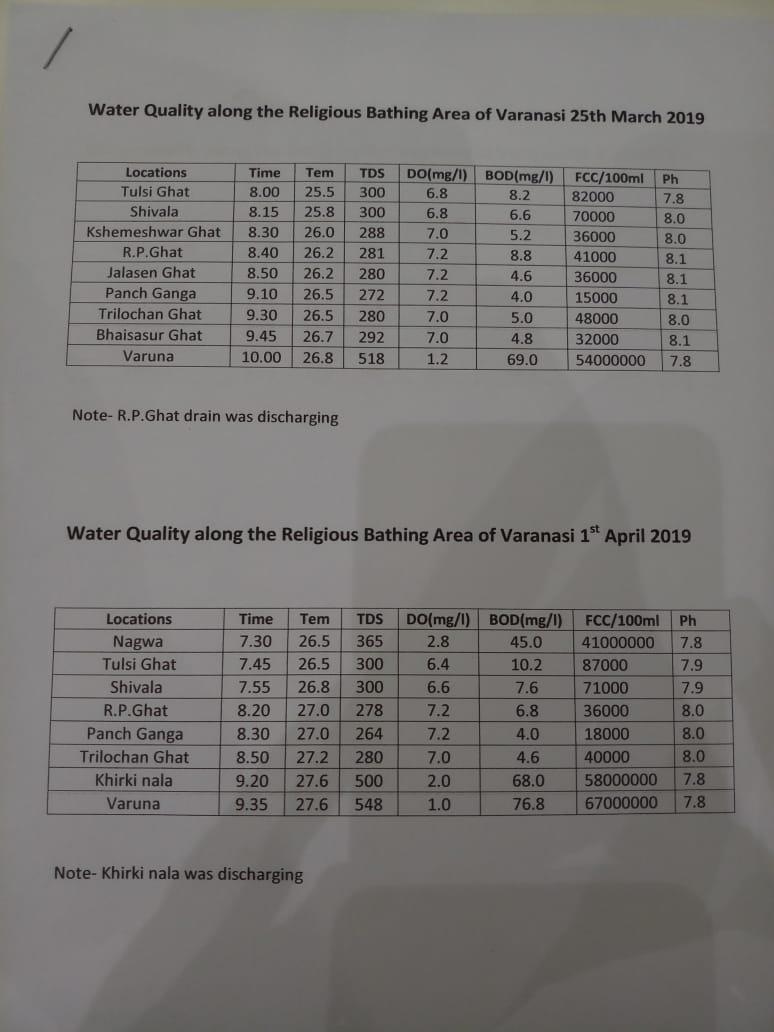
At Nagwa canal (the Assi confluence), which is near the upstream, the FC count is 41 million per 100 ml. In downstream at Varuna, it is 67 million. It has been measured at 36,000/100 ml at RP Ghat.
“It means the water quality is not even fit for bathing, forget about sipping. For sipping, there should no FC bacteria,” said Mishra.
The BOD level – which should be less than 3 mg/litre – has been recorded at 45 mg/litre at Nagwa, 10.2 mg/litre at Tulsi Ghat and 6.8 mg/litre at RP Ghat.
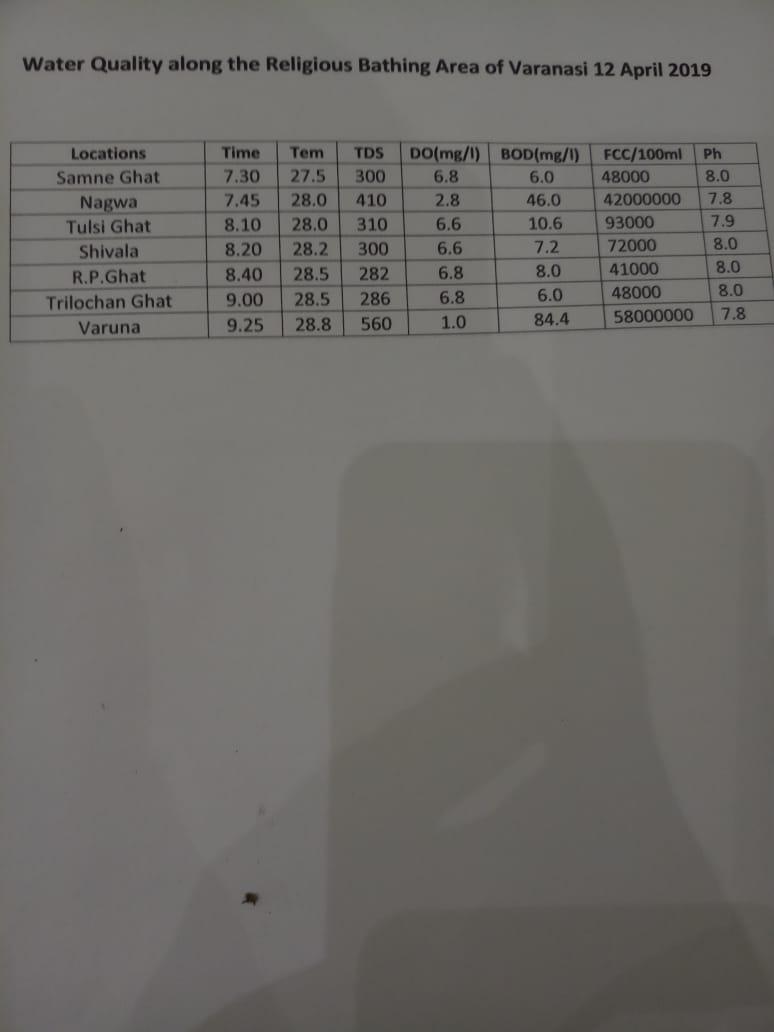
DO (dissolved oxygen) level is above five at all the places except for Nagwa, where it is 2.8. “If the DO level goes down, the aquatic life will vanish. The problem is not uniform everywhere, but where there is a heavy discharge of sewage, it is low. At points where it is one, it will become zero in summers. It changes throughout depending on the discharge,” he said.
“When PM Modi came to Banaras in 2014, he had met me. I narrated the entire story, and told him that the problem could not be solved with just political will. I had suggested to him that we sensitise the people and make it a people’s programme,” Mishra told NewsClick.
“You (the government) claim that we have done a lot, and have improved the infrastructure, but if these statistics are not changing, it means that all of these claims are just a lip service. I daily bathe in Ganga and offer my first prayer there. And there are over 50,000 people like me who do the same,” said Dr Mishra – who is also a ‘mahant’ (seer).
The river Ganga is basically a medium for national integration, he said, quoting Jawaharlal Nehru who, according to him, had said that the river is a silicon thread that binds the country together.
Also read: Modi’s Namami Gange a Failure, Says Report
Animal and human remains, pious refuse and floating waste have made the matter further worse. The National Green Tribunal (NGT) had, in 2016, criticised the Uttar Pradesh government for allowing dead bodies to be dumped into the river. The bodies of babies and unmarried women – of mostly Hindu faith – are not cremated, but are instead dumped into the water bodies. Even hospitals – say locals – sometimes dispose of bodies of patients that aren’t claimed.
However, officials claim that no dead bodies are disposed in the river.
B D Tripathi, in-charge of Banaras Hindu University’s Ganga Research Centre, said, “The water level in the river is going down at an unprecedented rate. Also, if the flow of the river is maintained, it can solve the problem of 60-80 per cent of organic pollutants, and we may not require such an elaborate programme.”
A saga of sewage treatment plants
Varanasi – according to official figures – generates around 32 crore litres of sewage per day (MLD). The available sewage treatment plants (STP) – Assi and Varuna – can only treat 101.8 MLD, while the rest flows directly into Ganga.
Existing STPs commissioned during the tenure of then Prime Minister Rajiv Gandhi’s tenure are now outdated. Frequent power cuts have made the problem worse.
There are three proposed STPs – which are under construction – to make sure that untreated water does not flow into the river. The proposed STPs – funded by Jawaharlal Nehru Urban Renewal Mission, the Japan International Cooperation Agency and one under the Namami Gange project – were to be completed by March 2018, but the construction is still underway.
As per Namami Gange targets, STPs with over 2,000 million litres a day capacity had to be rehabilitated, of which only 328 MLD have been done. A look at the status of all the projects undertaken makes one doubt whether the government would even achieve its revised deadline.
As far as sewage infrastructure projects are concerned, 68 projects were sanctioned after the Namami Gange was approved by the Cabinet and only six were completed till August. Till August 31, 2018, a total of 236 projects, including STPs, had been sanctioned out of which only 63 had been completed.
The government has said that the new projects are delayed because land acquisition and other related activities were taking a lot of time. However, poor performance in rehabilitating old STPs does not stand the test of time scarcity.
Modi had once said in Varanasi, “Mother Ganga is awaiting a son who will accomplish the task of cleaning the river.” The question is: how long will the river Ganga have to wait for her ‘sons’?
Also watch: Elections 2019: Reality of Sanitation Workers on the Banks of Ganga at Varanasi
Get the latest reports & analysis with people's perspective on Protests, movements & deep analytical videos, discussions of the current affairs in your Telegram app. Subscribe to NewsClick's Telegram channel & get Real-Time updates on stories, as they get published on our website.















